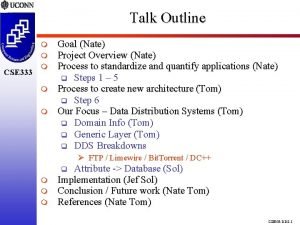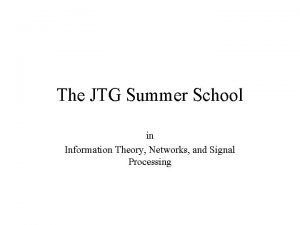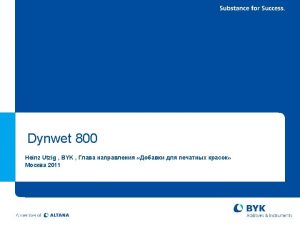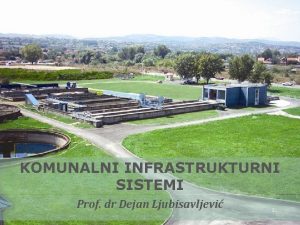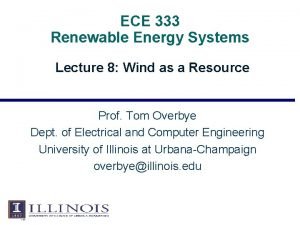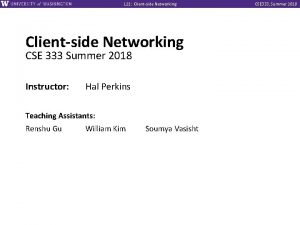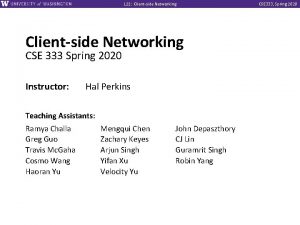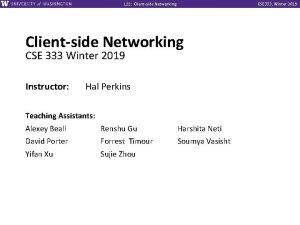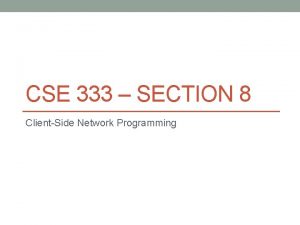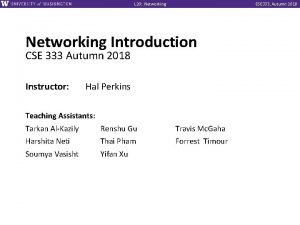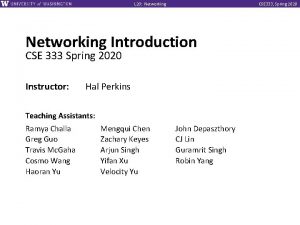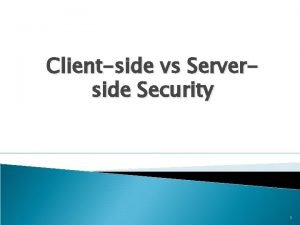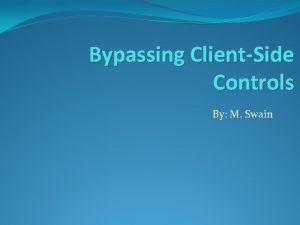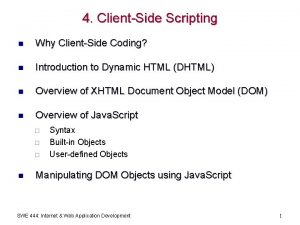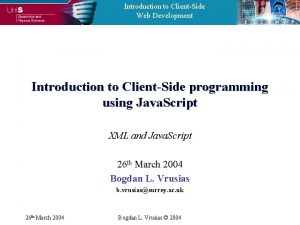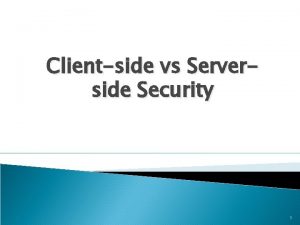L 20 Clientside Networking CSE 333 Summer 2021

















- Slides: 17

L 20: Client-side Networking CSE 333, Summer 2021 pollev. com/cse 333 cosmo How many hours have you spent on Homework 3 so far? A. B. C. D. E. F. G. [0, 4) hours [4, 8) hours [8, 12) hours [12, 16) hours [16, 20) hours 20+ hours Prefer not to say 1

L 20: Client-side Networking CSE 333, Summer 2021 Client-side Networking CSE 333 Summer 2021 Instructor: Cosmo Wang Teaching Assistants: Allie Pfleger Joyce Zhou Arpad (John) Depaszthory Kyrie Dowling Dylan Hartono

L 20: Client-side Networking CSE 333, Summer 2021 Administrivia v Homework 3 was due yesterday, late due this Sunday § Usual reminders: don’t forget to tag, clone elsewhere, and recompile v v Homework 4 will be released this afternoon § You can only use one late day on this hw § As usual, watch out for git conflict if you’re still working on hw 3 Exercise 10 to be released today and due Wednesday (8/11) § Client-side TCP connection § Based on this week’s lectures and section yesterday 3

L 20: Client-side Networking CSE 333, Summer 2021 Resolving DNS Names v The POSIX way is to use getaddrinfo() § A complicated system call found in #include <netdb. h> int getaddrinfo(const § Basic idea: char* hostname, const char* service, const struct addrinfo* hints, struct addrinfo** res); • Tell getaddrinfo() which host and port you want resolved – String representation for host: DNS name or IP address Set up a “hints” structure with constraints you want respected • getaddrinfo() gives you a list of results packed into an “addrinfo” structure/linked list • – Returns 0 on success; returns negative number on failure • Free the struct addrinfo later using freeaddrinfo() 4

L 20: Client-side Networking CSE 333, Summer 2021 getaddrinfo v getaddrinfo() arguments: § hostname – domain name or IP address string § service – port # (e. g. , "80") or service name (e. g. , "www") or NULL/nullptr § struct addrinfo { int ai_flags; int ai_family; int ai_socktype; int ai_protocol; size_t ai_addrlen; struct sockaddr* ai_addr; char* ai_canonname; struct addrinfo* ai_next; }; // // additional flags AF_INET, AF_INET 6, AF_UNSPEC SOCK_STREAM, SOCK_DGRAM, 0 IPPROTO_TCP, IPPROTO_UDP, 0 length of socket addr in bytes pointer to socket addr canonical name can form a linked list 5

L 20: Client-side Networking CSE 333, Summer 2021 DNS Lookup Procedure struct addrinfo { int ai_flags; int ai_family; int ai_socktype; int ai_protocol; size_t ai_addrlen; struct sockaddr* ai_addr; char* ai_canonname; struct addrinfo* ai_next; }; 1) 2) 3) 4) 5) v // // additional flags AF_INET, AF_INET 6, AF_UNSPEC SOCK_STREAM, SOCK_DGRAM, 0 IPPROTO_TCP, IPPROTO_UDP, 0 length of socket addr in bytes pointer to socket addr canonical name can form a linked list Create a struct addrinfo hints Zero out hints for “defaults” Set specific fields of hints as desired Call getaddrinfo() using &hints Resulting linked list res will have all fields appropriately set See dnsresolve. cc 6

L 20: Client-side Networking CSE 333, Summer 2021 Socket API: Client TCP Connection v There are five steps: 1) Figure out the IP address and port to connect to 2) Create a socket 3) Connect the socket to the remote server 4). read() and write() data using the socket 5) Close the socket 7

L 20: Client-side Networking CSE 333, Summer 2021 Step 2: Creating a Socket v Use socket() systemint calltype, int the socket(int domain, int protocol); § Creating a socket doesn’t bind it to a local address or port yet § Returns file descriptor or -1 on error socket. cc #include #include <arpa/inet. h> <stdlib. h> <string. h> <unistd. h> <iostream> int main(int argc, char** argv) { int socket_fd = socket(AF_INET, SOCK_STREAM, 0); if (socket_fd == -1) { std: : cerr << strerror(errno) << std: : endl; return EXIT_FAILURE; } close(socket_fd); return EXIT_SUCCESS; } 8

L 20: Client-side Networking CSE 333, Summer 2021 Step 3: Connect to the Server v The connect() system call establishes a connection to a remote host § int connect(int sockfd, const struct sockaddr* addr, socklen_t addrlen); sockfd: Socket file description from Step 2 • addr and addrlen: Usually from one of the address structures returned by getaddrinfo in Step 1 (DNS lookup) • Returns 0 on success and -1 on error • v connect() may take some time to return § It is a blocking call by default § The network stack within the OS will communicate with the remote host to establish a TCP connection to it • This involves ~2 round trips across the network 9

L 20: Client-side Networking CSE 333, Summer 2021 Connect Example v See connect. cc // Get an appropriate sockaddr structure. struct sockaddr_storage addr; size_t addrlen; Lookup. Name(argv[1], port, &addrlen); // Create the socket. int socket_fd = socket(addr. ss_family, SOCK_STREAM, 0); if (socket_fd == -1) { cerr << "socket() failed: " << strerror(errno) << endl; return EXIT_FAILURE; } // Connect the socket to the remote host. int res = connect(socket_fd, reinterpret_cast<sockaddr*>(&addr), addrlen); if (res == -1) { cerr << "connect() failed: " << strerror(errno) << endl; } 10

L 20: Client-side Networking CSE 333, Summer 2021 pollev. com/cse 333 cosmo How do we error check read() and write()? A. ferror() B. Return value less than expected C. Return value of 0 or NULL D. Return value of -1 read() E. We’re lost… Return Value -1 errno == EINTR 0 other errno >0 == count < count 11

L 20: Client-side Networking CSE 333, Summer 2021 Step 4: read() v v If there is data that has already been received by the network stack, then read will return immediately with it § read() might return with less data than you asked for If there is no data waiting for you, by default read() will block until something arrives § How might this cause deadlock? § Can read() return 0? read() Return Value -1 errno == EINTR 0 other errno >0 == count < count 12

L 20: Client-side Networking CSE 333, Summer 2021 Step 4: write() v write() queues your data in a send buffer in the OS and then returns § The OS transmits the data over the network in the background § When write() returns, the receiver probably has not yet received the data! v If there is no more space left in the send buffer, by default write() will block 14

L 20: Client-side Networking CSE 333, Summer 2021 pollev. com/cse 333 cosmo When we call write(), what data do we need to pass to it when writing over the network? A. Any data our application needs to send B. All of the above + TCP info (sequence number, port, …) C. All of the above + IP info (source & dest IP addresses…) D. All of the above + Ethernet info (source & dest MAC addresses) E. We’re lost… 15

L 20: Client-side Networking CSE 333, Summer 2021 Read/Write Example v See sendreceive. cc while (1) { int wres = write(socket_fd, readbuf, res); if (wres == 0) { cerr << "socket closed prematurely" << endl; close(socket_fd); return EXIT_FAILURE; } if (wres == -1) { if (errno == EINTR) continue; cerr << "socket write failure: " << strerror(errno) << endl; close(socket_fd); return EXIT_FAILURE; } break; } 16

L 20: Client-side Networking CSE 333, Summer 2021 Step 5: close() v int close(int fd); § Nothing special here – it’s the same function as with file I/O § Shuts down the socket and frees resources and file descriptors associated with it on both ends of the connection 17

L 20: Client-side Networking CSE 333, Summer 2021 Extra Exercise #1 v Write a program that: § Reads DNS names, one per line, from stdin § Translates each name to one or more IP addresses § Prints out each IP address to stdout, one per line 18
